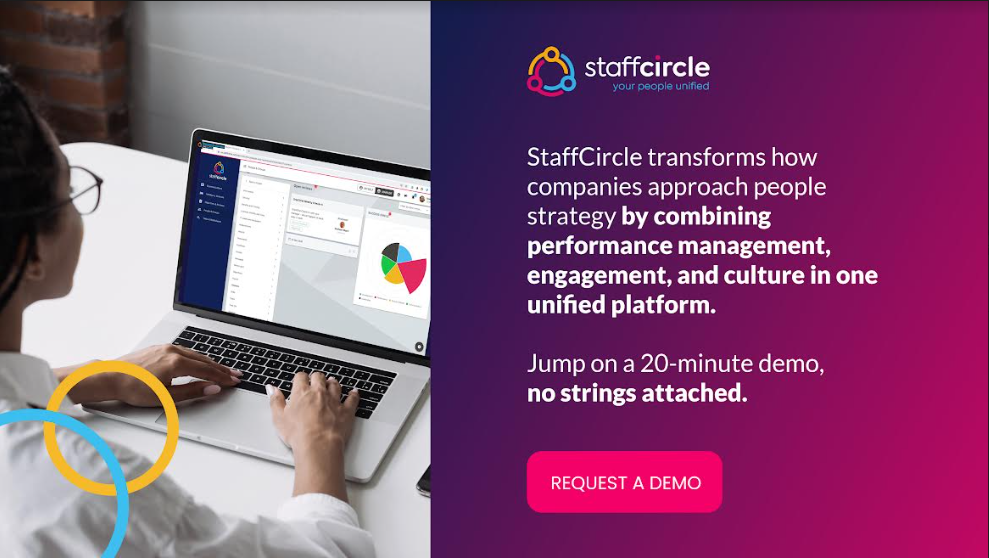How to drive objectives, develop talent and promote well-being through an employee performance management framework
Employee Experience, is a company-wide initiative to help employees stay productive, healthy, engaged, and on track.
Josh Bersin, founder Bersin Academy
Performance management for employees allows businesses to deliver learning and development to individuals and teams in a way that aligns with overall business strategy. Insights into the strengths and weaknesses of the people who compose their company allow managers and HR leaders to focus time and resources where they matter the most.
Traditional methods of annual performance appraisals are rapidly falling out of favour among successful organizations. Just as the transition from paper-based administration to fully digital processes is inevitable, so too is the way businesses approach the employee experience. With millennials making up a large percentage of the workforce, methods of engagement that reflect the age of social media are becoming increasingly dominant.
Today, employee performance management seeks to build a variety of mechanisms into the everyday activities of all members of staff. By using performance management software, both managers and their employees can integrate these processes into their workflow and deliver optimal outcomes.
There are a variety of scenarios in which approaches to defining an employee performance management framework can be tailored to achieve specific outcomes. These include:
- Training new hires and integrating them within the company.
- dealing with underperforming employees.
- upskilling existing employees for vertical or lateral promotions.
- managing employee performance for potential leadership roles.
- building a stronger sense of community in teams and departments.
Regardless of the desired outcomes, there are several key elements that should always be incorporated in an employee performance management framework. These elements include establishing goals, developing talent through continual feedback and using data to deliver a positive employee experience.
Let’s examine these elements in more detail and look at some best practices worth considering.
Setting realistic goals – encouraging autonomous, problem solving employees
Managing performance is often about establishing clear goals for employees to work towards. Such goals can be set for a wide variety of objectives that transcend basic performance-related goals such as sales and production quotas.
By establishing clear targets as defined through objectives and key results (OKRs) or key performance indicators (KPIs), managers can help drive success towards accomplishing:
- Professional development goals
- Creativity goals
- Soft-skill development goals
- People management goals
- Virtual communication goals
- Collaboration goals
Tracking these goals via performance management software ensures the necessary oversight to keep employees on track. At the same time, this clarity affords individuals the insights required to be able to adopt a proactive stance and develop a sense of autonomous problem-solving.
Best practices
- Set transparent goals. Transparent goals help to ensure that individuals, teams and departments are properly aligned. This alignment and visibility helps to mitigate against problems before they cause an issue.
- Tie employees’ goals to both personal ambition and the needs of the company. When an individual feels as if their personal growth is compatible with the requirements of their role, higher levels of engagement and performance are delivered.
- Measure what matters. Narrowing down the key performance indicators (KPIs) which matter the most allows managers and individuals to stay on the same page. Using performance management software to track these metrics in real-time keeps everyone working towards achieving key outcomes.
- Encourage collaborative goal setting. When team members take collective ownership of goals they work in a more effective, coordinated manner. Team goal calibration meetings add a layer of collaboration beyond the traditional peer feedback found in formal reviews.

Ongoing talent management – using an employee performance management framework to develop skills
Performance management tools integrated with HR admin features offer business leaders a unique insight into the talent composition of their organization. This information allows managers and HR leaders to make informed decisions regarding the allocation of training and development resources. It also means that skilled and experienced employees can be assigned to coaching and mentorship roles.
Developing employee skills as part of a performance management framework includes a range of activities. Not restricted to traditional training and courses, such development can also include networking, shadowing, and the development of soft skills such as public speaking. With individual strengths and weaknesses easily identified via a skills database, talent management programs can be tailored to meet the needs of each employee.
Research from UCL relating to happiness and learning sheds valuable light on the effectiveness of rewards on their employees. It suggests that learning play a more significant role, and providing an employee performance management framework that emphasises training may boost well-being.
“Our research suggests that how we learn can be more important for how we feel than the rewards we receive. In uncertain environments, happiness relates not to money but to something more like growth.”
In order for talent management programs to deliver the best results, it needs to be mutually beneficial to both the employee and the business. As John Bersin observes in the article A New Talent Management Framework:
“Organizations now realize that the problems of performance management, development planning, succession management, talent mobility, and leadership development must include a formal and transparent process to help people build their own careers.”
Best practices
- Establish clearly defined competency models. Businesses with a clear idea of core competencies required can deal more effectively with succession management and internal promotions. Using performance management software helps managers and HR leaders to map existing employee competencies onto roles within the company.
- Leverage existing talents within the organization to upskill employees. HR leaders are able to map and track the skill sets of employees. Use this information to connect individuals with employees who possess the desired skills and facilitate mentorships and coaching.
- Strategically invest in training and development. Talent management isn’t a one size fits all process. By using data analytics to assess the various levels of employee performance, resources for training can be oriented towards the individuals who need it the most.
Employee performance management and multi-channel communications – strengthening relationships with continuous feedback
I think it’s very important to have a feedback loop, where you’re constantly thinking about what you’ve done and how you could be doing it better.
Elon Musk
Teams can’t operate effectively if they exist in silos. And with many businesses operating on a hybrid work model mixing remote working with time in the office, multi-channel communications are essential to keep employees connected.
An employee performance management framework should be built upon a comms platform that integrates desktop/laptop devices with mobile phones. Coupled with push notifications, this ensures all members of staff are kept in the loop regarding important company developments.
Such a platform provides a foundation for ongoing conversations, both on a peer to peer basis and through regular one2one check-ins between managers and employees. These regular conversations have a profound impact on engagement and job satisfaction and can be easily scheduled through performance management tools.
As a report from Gallup highlighted, “employees who strongly agree they have had conversations with their manager in the past six months about their goals and successes are 2.8 times more likely to be engaged.”
Best practices
- Marshall all available communications channels. With employees open to a wide range of potential communications channels, make sure all avenues are explored. Use emails, messaging within performance management software, Microsoft Teams channels and SMS to ensure important information is delivered where it’s needed.
- Stick to a feedback schedule at all times. Business leaders with the best intentions of making ongoing feedback integral to their organization can still slip back into old bad habits. Managers and employees should stick to any schedule established for regular feedback, even if on the surface it seems there is little to say.
- Make feedback a core element of the company’s culture. If feedback is embedded into the company’s core ethos, getting employees to adhere to the principle will be much easier. Leaders can embody this principle and lead by example, for instance making positive feedback for great performance highly visible throughout the organization.
- Provide mechanisms for unsolicited employee feedback. Employees feel closer to the aims of the organization when they feel involved in the conversations which guide its evolution. Forums, intranets, discussion groups and other digital tools can be used via performance management software to empower spontaneous employee feedback.
Performance management and the employee experience – understanding the importance of well-being
Business leaders and HR professionals have long been concerned with alleviating workplace anxiety and promoting well-being. But with much of the workforce working from home, monitoring emotional and physical well-being presents new challenges and obstacles. Delivering a healthy employee experience for all employees requires new strategies which incorporate a panoply of digital tools.
As such, well-being initiatives should be incorporated into a businesses employee performance management framework. HR admin tools can be used to identify any employees facing problems working from home and spot patterns of absence and sickness which are tell-tale signs for low well-being.
Multi-channel comms combined with ongoing feedback allows for managers to address these issues early on and offer constructive interventions. By promoting an open-door policy when it comes to mental health concerns, employees can take positive steps towards improving their work-life balance.
Best practices
- Make well-being a part of regular ongoing feedback. When checking in with employees, managers and team leaders should be sure to factor in employee well-being. If feedback is touching on underperformance, there may well be factors in an employee’s personal lives contributing to their negative impact which such conversations will bring to light.
- Encourage activities which boost employee well-being. A company’s intranet is a great place to connect individuals and encourage them to participate in activities which will improve physical and mental health. Visibly facilitating such activities makes it clear the organization places significance on well-being.
- Create an office environment conducive to well-being. Designing a working environment which promotes well-being helps establish a positive frame of mind from the outset. Office spaces should be designed to encourage an inclusive culture, with communal areas to help facilitate health relationships between employees.
Improving approaches to employee performance management – marshalling AI and data analytics
Data analytics and reporting provide a fundamental foundation of an employee performance management framework. This should be implemented regardless of how the framework may be tailored for specific outcomes.
In his article for the Harvard Business Review, Tom O’Toole outlined an approach to data that works towards delivering quantifiable results. He suggests business leaders should
“identify a small number of “high-leverage” business problems that are tightly defined, promptly addressable, and will produce evident business value, and then focus on those to show business results. The specific business problem drives the team to identify the data needed and analytics to be used. Quick wins demonstrate business value.”
The same principles apply when using data to help drive employee performance management decisions. Managers and employees alike benefit from tightly defined metrics that can be closely measured and acted upon. Furthermore, available data helps to validate decisions and can be used to drive performance-related practices moving forwards.
Best practices
- Collect data strategically. With performance management and HR software able to collate a wide array of data, focusing on what matters the most is key. Have a clear understanding of the metrics which will bring the greatest value to the organization.
- Use data visualization tools to present findings. Raw data in and of itself can be rather headache-inducing. Use performance management tools and other resources to present data in a more palatable way so that it is clearly understood.
- Use data proactively. Real-time data brings valuable insights to an organization which allows them to preempt problems rather than simply react to them after the fact. For example, attendance data can give HR leaders an insight into employees who are developing unhealthy absence patterns and can intervene early.



